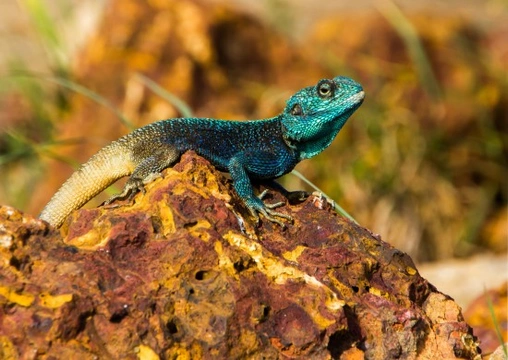
The natural behaviour of lizards
In order to provide the optimum living environment for your pet lizard, it is important to fulfil all of their basic requirements in terms of food, shelter, warmth and humidity, and a safe, comfortable enclosure. However, your lizard will not thrive if their living environment does not closely mimic their natural habitat, nor if they are unable to display their natural behaviours and lifestyles.
While there are a huge range of different lizard species in the world, they generally all share the same common needs, and require similar provisions to keep them happy. Lizards actively seek out light and heat to stay comfortable, and suitable foods to both keep them fed and fulfil all of their nutritional requirements. They also have certain ways of alerting potential mates to their presence and finding a partner for reproduction, but there is much more to lizard behaviour than just these basics!
Read on to learn more about some of the more interesting and sometimes complex lizard behaviours and activities.
Lizard circumduction
Circumduction is one of the methods that lizards use to communicate with each other, and is part of a submissive display pattern that encourages other lizards to accept the presence of the other party and not see them as a threat. Circumduction manifests itself as “waving” of one of the front legs to another lizard, as if greeting them by waving hello!
This is lizard-speak for “hi, I’m over here; I’m not going to hurt you, and I would appreciate it if you would not hurt me either.” Circumduction is usually displayed by the submissive or smaller lizard to a larger or dominant one, and is usually displayed by female lizards to both larger males and larger females.
It is most commonly seen within Bearded Dragons, although other types of lizards may also utilise circumduction on occasion too.
Lizards making themselves look larger than they are
Like many other animals, lizards will sometimes seek to physically alter their appearance or stance so as to appear larger, more impressive, or more threatening than they really are. This is known as “displaying,” and is an important tool in the lizard’s armoury to try to make themselves look less like an appealing snack to predators, or to discourage another lizard from thinking they have a good chance in a fight!
When displaying, lizards will puff themselves up with air in the same way that people might puff out their chests, and may stand up proudly on their legs to appear taller. Lizards of some varieties, such as the Chameleon, can actually alter the appearance of the tone and colour of their scales, either to blend in closely to the background or to appear more distinct from it and so, more impressive.
However, displaying can only be seen to its full effect when the lizard is looked at side-on; looking at the lizard head-on will not show the full benefit of their display. The Chameleon and the Great Green Iguana are two of the best-known display lizards, and yet, if you view them from the head or from the back when in display posture, they will actually appear rather narrow and thin, as they are moving their bodies to look as wide as possible from the side!
Climbing and location within trees
Lizards are of course great climbers, and in the wild can generally be found in trees rather high from the ground! The behaviour of the Great Green Iguana is again particularly interesting in this respect; how high within any set of trees a given Great Green Iguana can be found will depend largely on their age!
Like most young animals, baby iguanas do not fully develop their immune systems and the necessary intestinal flora to digest their food and protect them from sickness until they are around three months old, during which time they can be found dwelling on the lower thirty feet of trees and vegetation.
Older, and so more mature lizards will dwell higher up the tree, and their poop and natural gut flora naturally moves down the tree onto the lower branches, offering effective protection to the immune systems of younger lizards and allowing the necessary flora cultures to develop within their own intestines. By the time they are around three months old, they will be fully protected, and slowly begin their move higher up into the trees!
This bacteria and intestinal flora is essential for lizards, in order to enable them to digest the tough cellulose plant fibre of the leaves and branches that they consume. Within the domestic environment, baby lizards do not develop this intestinal flora and natural protection, which causes them to grow at a slower rate than their wild counterparts. This means that ensuring your lizard receives a balanced diet and all of the essential nutrients that they need from their food is down to you, their owner to ensure, in order to keep them healthy and well in captivity.



